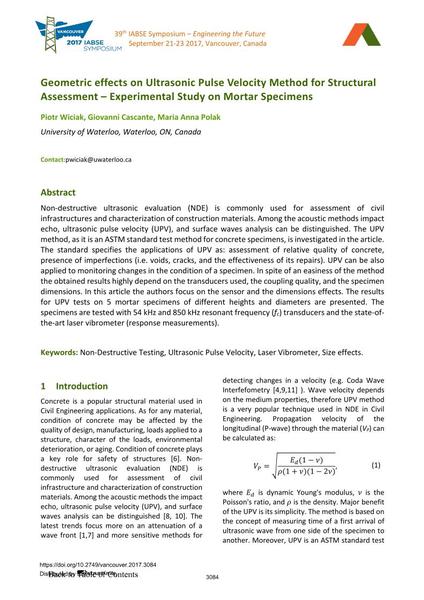Geometric effects on Ultrasonic Pulse Velocity Method for Structural Assessment – Experimental Study on Mortar Specimens

|
|
|||||||||||
Détails bibliographiques
| Auteur(s): |
Piotr Wiciak
(University of Waterloo, Waterloo, ON, Canada)
Giovanni Cascante (University of Waterloo, Waterloo, ON, Canada) Maria Aanna Polak (University of Waterloo, Waterloo, ON, Canada) |
||||
|---|---|---|---|---|---|
| Médium: | papier de conférence | ||||
| Langue(s): | anglais | ||||
| Conférence: | IABSE Symposium: Engineering the Future, Vancouver, Canada, 21-23 September 2017 | ||||
| Publié dans: | IABSE Symposium Vancouver 2017 | ||||
|
|||||
| Page(s): | 3084-3091 | ||||
| Nombre total de pages (du PDF): | 8 | ||||
| Année: | 2017 | ||||
| DOI: | 10.2749/vancouver.2017.3084 | ||||
| Abstrait: |
Non-destructive ultrasonic evaluation (NDE) is commonly used for assessment of civil infrastructures and characterization of construction materials. Among the acoustic methods impact echo, ultrasonic pulse velocity (UPV), and surface waves analysis can be distinguished. The UPV method, as it is an ASTM standard test method for concrete specimens, is investigated in the article. The standard specifies the applications of UPV as: assessment of relative quality of concrete, presence of imperfections (i.e. voids, cracks, and the effectiveness of its repairs). UPV can be also applied to monitoring changes in the condition of a specimen. In spite of an easiness of the method the obtained results highly depend on the transducers used, the coupling quality, and the specimen dimensions. In this article the authors focus on the sensor and the dimensions effects. The results for UPV tests on 5 mortar specimens of different heights and diameters are presented. The specimens are tested with 54 kHz and 850 kHz resonant frequency (fc) transducers and the state-of- the-art laser vibrometer (response measurements). |
||||
